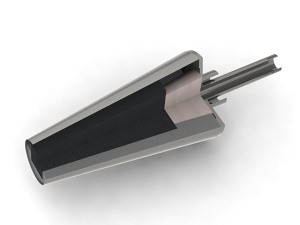Analysis of the use characteristics of diffused ventilation bricks
Because of its microstructure characteristics, the new diffused ventilation brick will not produce the phenomenon of impermeability or poor bottom blowing of the slit sandwiched steel structure often seen in the original slit ventilation brick. When the slit ventilation brick is working and ventilating, the air-conditioning The activity in the slit produces a large temperature gradient, and part of the thermal stress generated is concentrated near the slit, especially the thermal stress at the gas outlet of the slit, which causes the size of the slit to change during use, resulting in the easy intrusion of molten steel. The bottom blowing is not penetrated or bad in the slit. Also, if the bottom blowing valve is quickly closed at the end of the purification process, the molten steel will enter the slit with positive pressure, so it is necessary to install a reverse infiltration one-way stop valve on the argon blowing pipeline.
Therefore, the slit-type ventilating brick must have suitable and stable slit airway dimensions and materials with good thermal stability to reduce the slit steel. As shown in Figure 2), these micron-scale tortuous channels constitute a large resistance to molten steel infiltration, and are basically impermeable to steel in actual use. The air bubbles generated by the diffused permeable brick are small, uniform and dense, and are easier to Stir the molten steel to a uniform temperature, and it is easier to cause the inclusions to float up and achieve a better purification effect.
The new diffused permeable brick is not easy to produce cross-section of the surface of the brick core. When blowing argon, the general slit type permeable brick is in direct contact with the high-temperature molten steel at the outlet of the slit and the cold air flows out continuously, resulting in a large temperature gradient and forming a slit. The thermal stress at the air outlet is particularly large, coupled with the rapid cooling and rapid heating during use, it is easy to cross-cut near the air outlet of the slit, causing the slit to shift and the bottom to blow through. It is easy to form slit-type breathable bricks to produce cross-sections, which puts forward relatively high requirements for the thermal shock resistance of refractory materials. However, there are micron-scale gas channels on the entire working surface of the diffused breathable bricks. The temperature gradient is small, so the new diffused air-permeable brick is not easy to produce cross-section of the surface of the brick core.

Related News
- Introduction of construction method of ramming material in intermediate frequency furnace
- How to choose the material of furnace lining
- The difference between rammer and castable
- Application direction of intermediate frequency furnace refining
- Introduction to the construction method of dry ramming material
- Do you know the production process and control points of breathable bricks?
- The application of argon blowing technology at the bottom of the intermediate frequency furnace
- Method for prolonging service life of intermediate frequency furnace lining
- In addition to diffused breathable bricks, there are those types of breathable bricks
- What are the advantages of coil cement
- What are the specific functions of the use of carbon ramming materials?
- Will the furnace lining affect the furnace temperature of the copper alloy?
- How to use intermediate frequency furnace ramming material in stainless steel furnace
- What causes damage to the breathable brick
- How much do you know about the characteristics of ramming materials?
- A brief introduction to whether the more expensive the furnace lining, the better
- What is the baking process of furnace lining
- Method for prolonging the service life of intermediate frequency furnace lining
- How to apply the correct construction of the ramming material
- How to Improve the Use Efficiency of Ladle Blowing Argon


